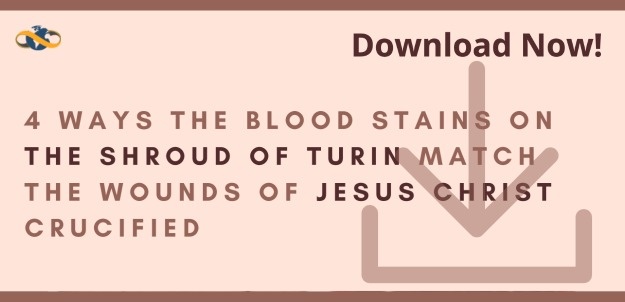In this talk from the 2017 Napa Institute Conference, Father Spitzer delves into five pieces of scientific evidence for the authenticity of the Shroud of Turin (you can also watch the presentation in the video included at the bottom of this article). The implication of such evidence is that the Shroud’s origin can be traced back to Jesus Christ Himself.
What is the Shroud of Turin?
The Shroud of Turin is a 14-foot cloth with a man sketched into it. No other historical document has been scientifically examined to the extent that the Shroud has. As Father Spitzer explains, the extensive studies of the Shroud have revealed that there are certain enigmas that almost certainly suggest that the Shroud is subject to divine causes.
A perfect, 3-dimensional image, the Shroud of Turin represents the figure etched into it with incredible detail despite being made from extremely sensitive cloth. The full body can be seen in the image and has been confusing to many scientists, even those who have attempted to disprove any semblance of divine influence in its origin.
Problems with 1988 Carbon Dating of the Shroud of Turin
In 1988, seven samples were taken from the Shroud of Turin in order to conduct carbon dating to determine the year of origin. However, instead of following the natural protocol of taking seven samples to be examined by seven different labs, only three samples were taken from one corner of the Shroud of Turin. The scientists Joseph Marino and Sue Bentard found cotton fibers believed to have originated in the 15th century.
However, Dr. Raymond Rogers conducted a vanillin test, which dates the decay in fabric over time. The test showed that vanillin levels were low in the Shroud and that its origin could be traced back to sometime before the 3rd century. The vanillin content was too low for the Shroud to have been made before that time. Additionally, after conducting infrared spectroscopy tests, Rogers found that all results showed an average date of A.D. 50, plus or minus about 500 years, with 96% certainty.
External References for Place and Date of the Shroud of Turin
Next, Father Spitzer explains multiple pieces of evidence that demonstrate the origin of the Shroud of Turin being traced back to the time and place of Jesus Christ.
- Dr. Max Fei found pollen grains within the Shroud of Turin, which is indigenous to Judea, particularly northern Jerusalem. He discovered that the cloth was exposed in northern Judea for some time, moved to Odessa, Turkey, and then finally to Constantinople. In fact, right around the time when the Shroud was believed to have come to Odessa, a radical shift coincidently occurred in Christian iconography, depicting Jesus more as a Semitic man with dark features and long hair, exactly how he is seen on the Shroud.
- For a long time, people could not understand why there were two Roman leptons on the eyelids of the man in the Shroud. There were unique coins that could not be traced back to any origin other than the fact that they were Roman. However, a study found that the coins possessed a special minting, which was done by Pontius Pilate in Jerusalem in the year A.D. 29. This correlation is beyond coincidental as this was exactly around the time Jesus Christ was alive.
Bloodstains on the Shroud of Turin
Another startling piece of evidence comes in the form of the bloodstains on the shroud. In fact, the bloodstains on the image have been shown to have originated before the image was even present on the cloth. All the wounds are vertically juxtaposed, showing that whoever is on the cloth suffered a death by crucifixion. Additionally, the blood stains show severe stress, which demonstrates that an artist did not create the Shroud but actually contains blood (genuine hemoglobin) with an AB+ type.
The wounds that are found on the shroud show head wounds (from the crown of thorns), wounds on the side (from a Roman pilum), and wounds on the wrists, feet, and ankles (from the nails). The likelihood of all of the 124 blood stains being identical is close to impossible, yet they are.
More Evidence for the Shroud of Turin
As Father Spitzer explains, there is no other image like the Shroud of Turin in the history of the world. He gives five major pieces of evidence for its unique status:
- The Shroud of Turin is a precise photographic negative taken on a photographically sensitive cloth in a time when photographs did not exist.
- The image has been proven not to have been produced by paint, dye, vapors, or scorching, implying that it was not created by an artist.
- The image of the Shroud of Turin is restricted to the uppermost parts of the fibrils in the cloth and does not penetrate into the medulla of the fiber. There is no other image that has done this.
- The blood imprints on the Shroud preceded the formation of the actual image.
- 3D imaging of the Shroud shows bones inside the hand and flesh surrounding the bone.
What Father Spitzer demonstrates is that the Shroud of Turin is no ordinary image. In fact, by supplying a myriad of evidence, Father shows that the Shroud of Turin originated around the year A.D. 29. in Judea. It is a perfect photographic negative of a man who underwent a unique crucifixion, and there is no other image like it. Although many will still deny the spiritual implications of the Shroud, the evidence is becoming increasingly hard to deny.
Cover Image: Mogadir, CC BY-SA 3.0 / via Wikimedia Commons and cropped to 1,700x850px.


